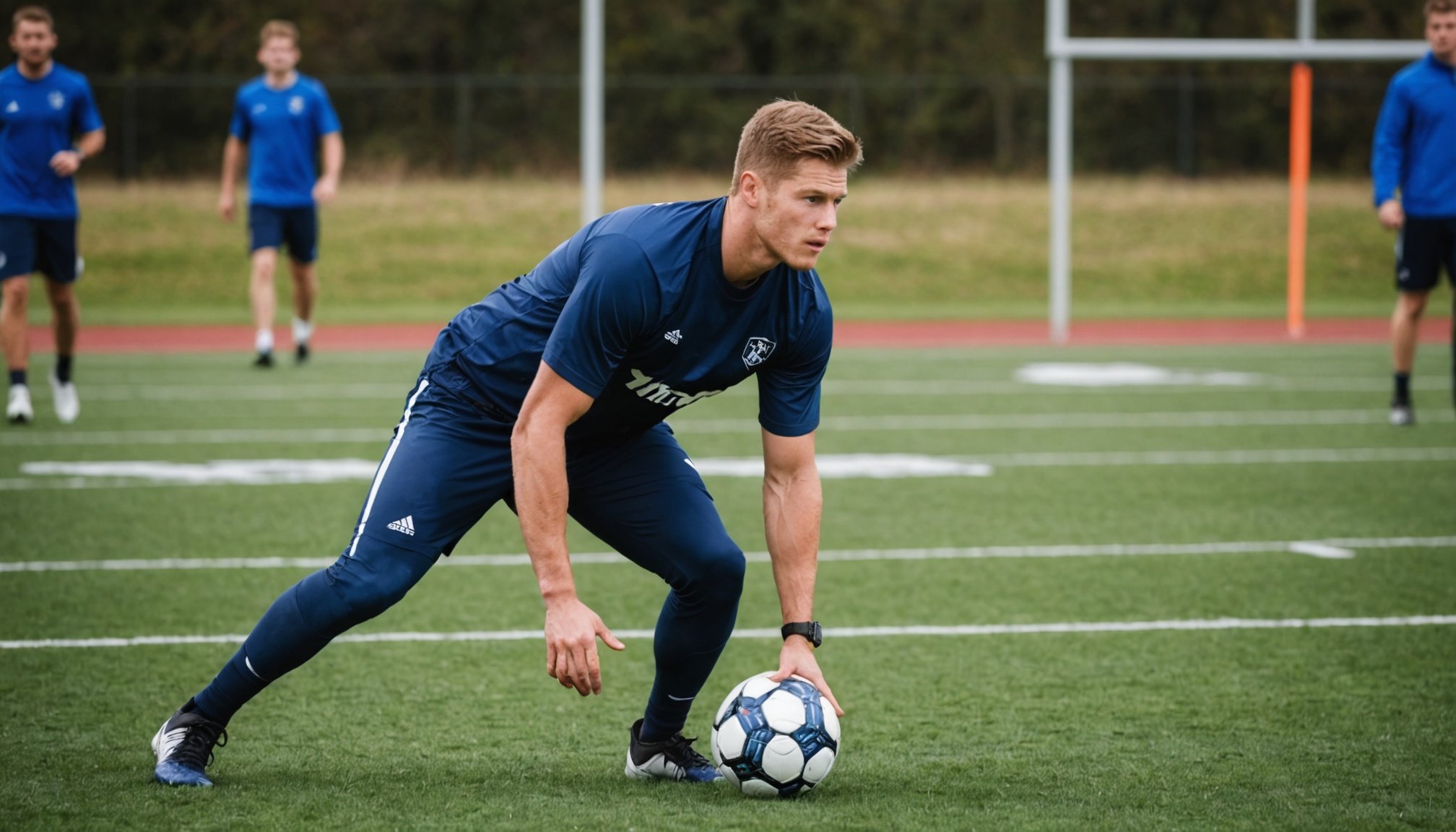Unlocking Off-Season Success: The Advantages of Cross-Training for Football Players
As the football season comes to a close, many players and coaches turn their attention to the off-season, a critical period for improvement, recovery, and preparation for the next game. One of the most effective strategies for achieving peak performance during this time is cross-training. In this article, we will delve into the advantages of cross-training for football players, exploring how it can enhance strength, performance, and overall fitness.
Understanding Cross-Training
Cross-training involves engaging in various physical activities and exercises outside of the primary sport to improve overall athletic performance. For football players, this can include a range of activities such as track and field, strength training, plyometrics, and even other sports like soccer or basketball.
Additional reading : Enhancing Game-Day Decisions: The Power of Mindfulness for Football Players
Why Cross-Training is Essential
Cross-training is not just about filling time during the off-season; it is a strategic approach to enhancing athletic performance. Here are some key reasons why cross-training is essential for football players:
-
Injury Prevention: Cross-training can help reduce the risk of overuse injuries by varying the types of stress placed on the body. For example, if a player is used to the high-impact nature of football, incorporating lower-impact activities like cycling or swimming can provide a welcome respite while still maintaining cardiovascular fitness[3].
Also to discover : Mastering Multicultural Communication: Top Strategies for Success in Football Teams
-
Improved Strength and Power: Strength training is a cornerstone of cross-training for football players. Exercises like squats, deadlifts, and bench presses can significantly enhance lower body strength and overall power output. This is particularly beneficial for players who need to improve their explosive power, such as linemen and linebackers[2].
-
Enhanced Speed and Agility: Cross-training can include speed and agility drills that are not typically part of standard football training. For instance, track and field events like the 100-meter dash or shuttle runs can improve acceleration and deceleration skills, which are crucial for football players[2].
Tailoring Training to Athlete Types
Not all athletes are created equal, and their training programs should reflect their unique biomechanical and physiological profiles. Here’s how to tailor cross-training programs based on different athlete types:
For Wide ISA Athletes
Athletes with a wide Interlimb Symmetry Angle (ISA) tend to rely on muscular force and strength for their movements. Here are some tips for their cross-training:
- Focus on Strength and Power: These athletes benefit from strength-based lifts like squats and deadlifts. High-intensity sprints with long recovery periods can also enhance their explosive power[2].
- Incorporate Lateral Work: Lateral bounding and agility drills support their natural stride width and lateral stability.
- Enhanced Exhalation Power: Training that emphasizes thoracic pressure, such as weightlifting, can enhance stability during forceful movements.
For Narrow ISA Athletes
Athletes with a narrow ISA tend to rely more on elasticity and rhythm. Here’s how to tailor their cross-training:
- Focus on Elasticity and Rhythm: Plyometric exercises, rhythm drills, and tempo sprints are ideal for building on their elastic qualities.
- Reinforce Linear Movements: Linear bounding and coordination exercises take advantage of their rotational strength and bounciness.
- Light Strength Work: Keep strength training lighter and more dynamic to avoid diminishing elasticity[2].
For Athletes in the Middle
Most athletes fall somewhere in between the wide and narrow ISA categories. Here’s how to approach their cross-training:
- Blended Approach: Include a mix of plyometric and strength training to cover both elasticity and power.
- Monitor Individual Responses: Adjust training based on what optimizes their performance.
- Focus on Sport-Specific Needs: Tailor drills to the specific demands of their sport, whether that requires more bounciness, strength, or agility[2].
The Role of Plyometrics in Cross-Training
Plyometric training is a crucial component of cross-training for football players, particularly when it comes to improving power and speed.
Intensive vs Extensive Plyometrics
Plyometric exercises can be categorized into intensive and extensive types, each with its own benefits:
-
Intensive Plyometrics:
-
Characteristics: High-intensity, low-volume exercises.
-
Examples: Box jumps, depth jumps.
-
Benefits: Improve Rate of Force Development (RFD), enhance explosive power, critical for sports like football and basketball[3].
-
Extensive Plyometrics:
-
Characteristics: Low-intensity, high-volume exercises.
-
Examples: Bounding, skipping, continuous jumping.
-
Benefits: Improve endurance and overall power output over longer durations, beneficial for sports like soccer and distance running[3].
Combining Intensive and Extensive Plyometrics
For optimal results, football players can benefit from a combination of both intensive and extensive plyometrics:
- Improving RFD and Endurance: Intensive plyometrics enhance RFD, while extensive plyometrics improve the ability to sustain power output over longer periods.
- Customizing Training: Depending on the player’s position and the specific demands of the game, the balance between intensive and extensive plyometrics can be adjusted. For example, linemen might focus more on intensive plyometrics for explosive power, while wide receivers might benefit from a mix to enhance both speed and endurance[3].
Cognitive Benefits of Football Training
While physical training is paramount, football training also offers significant cognitive benefits, especially for younger athletes.
Enhancing Cognitive Performance
Studies have shown that football training can improve cognitive functions such as attention, inhibitory control, and working memory. Here are some key findings:
- Attention and Inhibitory Control: Football training has been shown to enhance attention and inhibitory control in children and adolescents, which are crucial for both academic and athletic success[5].
- Working Memory: Engaging in football training can improve working memory, allowing athletes to better process and retain information during games[5].
- Executive Function: The dynamic nature of football requires quick thinking and strategic planning, which can enhance executive function skills such as cognitive flexibility and decision-making[5].
Practical Insights and Actionable Advice
Here are some practical tips and actionable advice for football players looking to incorporate cross-training into their off-season regimen:
Creating a Balanced Training Program
- Strength Training: Include strength-based exercises 2-3 times a week to build overall strength and power.
- Plyometric Training: Incorporate both intensive and extensive plyometric exercises to improve RFD and endurance.
- Speed and Agility Drills: Add speed and agility drills to enhance acceleration and deceleration skills.
- Recovery Time: Ensure adequate recovery time between high-intensity workouts to avoid overtraining and injury.
Example Training Schedule
Here is an example of what a weekly cross-training schedule might look like for a football player:
| Day | Morning Session | Afternoon Session |
|---|---|---|
| Monday | Strength Training (Lower Body) | Speed and Agility Drills |
| Tuesday | Intensive Plyometrics | Recovery (Light Cardio) |
| Wednesday | Rest | Rest |
| Thursday | Strength Training (Upper Body) | Extensive Plyometrics |
| Friday | Speed and Agility Drills | Mental Conditioning |
| Saturday | Cross-Training (Other Sport/Activity) | Recovery (Stretching and Foam Rolling) |
| Sunday | Rest | Rest |
Quotes from Experts
-
“Understanding an athlete’s ISA type can guide training decisions, allowing us to create programs that leverage their natural biomechanics,” says a strength and conditioning coach. “This approach ensures that athletes are training in a way that maximizes their strengths rather than forcing them into a rigid category”[2].
-
“Football training holds promise for enhancing cognitive function in children and adolescents, particularly in attention, inhibitory control, and working memory,” notes a researcher in the field of sports psychology. “This makes it a valuable component of both athletic and academic development”[5].
Cross-training is a powerful tool for football players looking to enhance their performance during the off-season. By incorporating a variety of exercises and activities tailored to their unique biomechanical profiles, athletes can improve their strength, power, speed, agility, and even cognitive functions. Whether through intensive plyometrics, extensive plyometrics, or a balanced strength training program, cross-training offers a comprehensive approach to achieving peak performance.
In the words of a seasoned coach, “The off-season is not just about recovery; it’s about preparation. By leveraging cross-training, football players can come back stronger, faster, and more agile than ever before.”
So, as you embark on your off-season training, remember that cross-training is more than just a supplement to your regular football training—it’s a key to unlocking your full potential as an athlete.











